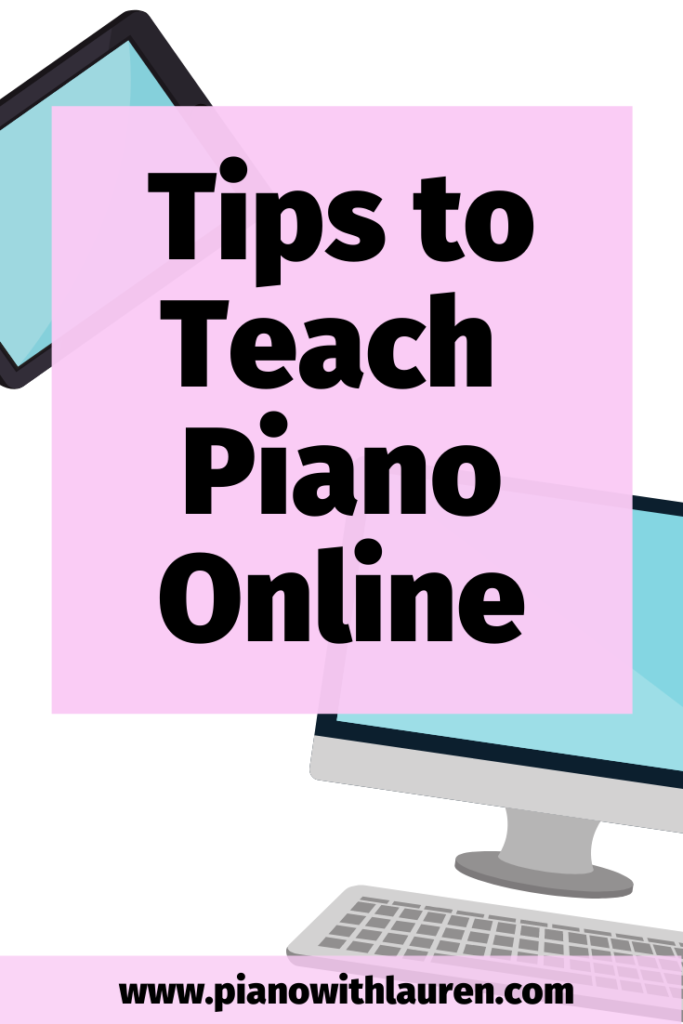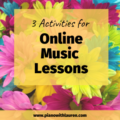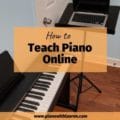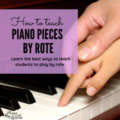This post may contain affiliate links. As a Sheet Music Plus and Amazon Associate, I earn from qualifying purchases. That means I make a small commission (at no additional cost to you) if you purchase something from an affiliate link.
Teaching piano lessons online has become essential during the COVID-19 Pandemic. However, you may find that you continue teaching piano lessons online even after the pandemic and social distancing is over. Teaching piano lessons online is a great way to continue teaching when students move, are mildly ill, or have transportation issues. Here are some tips for teaching online lessons. (Be sure to check out my full post for how to teach piano lessons online here.)

- When at all possible, use a wired internet connection.
A wired connection is not as neat as using wireless WiFi. However, having a good, strong connection on your end helps ensure that there are less technical issues during the lessons. I run a long 50-foot ethernet cable from my router to my computer for lessons. - Play games.
Online piano lessons do not have to be just for repertoire. There are many rhythm and ear training activities that you can do during online lessons. See this post here for some ideas. If a student seems to be having a difficult day, you can lighten the mood of the lesson by doing some activities. - Talk less.
I have found it helpful to listen more and talk less during online lessons. If you talk while a student is playing (as if you are actually together), it can really distract the student. When I first starting teaching online lessons, I tried to say something while the student played, and they always stopped. It is very distracting for students! - Ask more questions for self-discovery.
Taking piano lessons online helps develop students’ independence. Students will write down their own assignment, number their own measures, and make their own markings in their music. Ask questions about the music throughout the lesson to develop these skills even more. - Use the same edition as the student and number all measures.
Be sure that you have a copy of the student’s music with you. If you and the student use the same edition and both have your measures numbered, it will really help you and the student to discuss the music with ease. - Sit comfortably.
Yikes! I learned this the hard way. I made the mistake of sitting on my piano bench for a week. I had to turn to face my computer at the side and then turn to play the piano. My back was killing me! I switched to a comfortable desk chair at my piano (like this one) and it eased all back pain! - A small whiteboard is very helpful.
I love my small whiteboard! I draw symbols or notes on the staff throughout the lesson. You can also use small adhesive magnets and printable rhythm cards on it for an easy activity with students. - Keep lesson notes while you teach.
As teachers, we often rely on the notes we leave in the student’s assignment book. For online lessons, you will have to keep your own notes. I jot down notes in a notebook or my iPad throughout online lessons. - Keep your professional standards high.
It is a little tempting to check your phone or send a quick text during lessons. Please don’t do this! It lessens the quality of online lessons if your students look for your input and you are looking down or distracted. - The pacing of lessons will be different.
Because students are writing their own notes, each element of the lesson will take a little more time. You may not accomplish the same amount during an online lesson that you would otherwise. - Offer extras.
Have an online group class for your students. They will enjoy seeing each other and hearing each other play. Read this post about how to have an online group class for your students. - Have an online recital!
You can either make a YouTube playlist of your students playing (ask the parents to send a video to you) or have a live recital on Zoom. Just follow the instructions on having an online group class to do the online recital.

Lauren teaches piano to students of all ages. She enjoys creating resources for her students and teachers. She is the author of Ready for Theory®. For personalized help, check out the consultations page for teachers.




